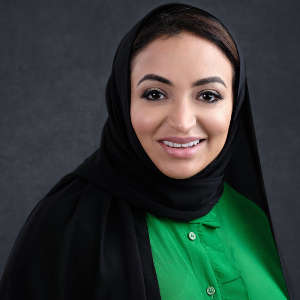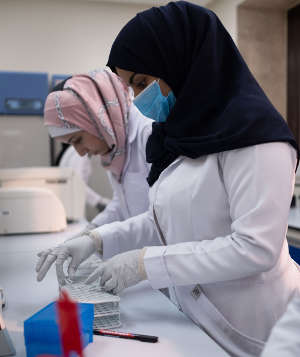Using AI to control energy for indoor agriculture
30 September 2024
Published online 26 November 2019
Science needs more female role models, says Saudi geneticist Malak Abdelalthagafi1 .

Malak Abedalthagafi
In early 2016, I established an all-female lab at King Fahad Medical City in Riyadh as a satellite site for the Saudi Human Genome Project, sponsored by King Abdulaziz City for Science and Technology (KACST), which later became the genomics research department.
Initially, KACST provided me with four female researchers. I later hired another three, based purely on qualification merit. Volunteers have all been female, including a genetics counsellor and two pathology residents. In April 2019, I hired a male PhD scientist; again, based on qualifications. Earlier this year, I established a new collaboration with a male surgeon, who has a team of another four women, to work with my team in the immunogenetics of liver cancer.
My female colleagues are open about their issues and strive for harmony at work, in partnerships, and in their personal life. They want to change stereotypes about women's abilities and success in scientific and medical research.
On average, women who work full-time outside the home still bear more of the burden of household labour and management compared to employed men3 . Women shouldn’t be made to feel they must give everything equal weight at all times. Sometimes their family or their career needs more attention. Women should be made to feel comfortable to negotiate their priorities, while family, and employers, should have realistic expectations.
As I built up my lab, I realized that my chief role was to set up a platform of support for my team members, helping them to build their confidence and understand that the balance between family life and research will not be an issue for our team. In some work environments, people feel wary about allowing their life and family to interrupt their work because they worry it will affect the way they are perceived by their employers. Knowing that, I set up my lab in a way that encourages open communication and flexibility, so that scientists can excel in their research without neglecting their other responsibilities.
It's been tough, but also rewarding, as more young female researchers join us. As a leader, I have come to realize that identifying and addressing preconceptions makes for a strong, inclusive research environment that can thrive in a traditionally masculine community. The fact that women are less visible in STEMM fields perpetuates outdated beliefs about gender. A sense of belonging influences women’s interest, persistence, and success in STEMM fields.
Simply being an outspoken presence as a capable female role model in science is crucial because the majority of leaders in most STEMM fields are men, and male students have easy access to many models and mentors who are like them. Having mentors of the same gender, ethnicity, or cultural background can help students from underrepresented groups feel included and capable4 . That is why I take deliberate action to provide female students with female STEMM role models and mentors as an essential part of lab management.
As a female STEMM leader, I incorporate specific strategies that I’ve learned to encourage female success in a male-dominated environment.
Build self-esteem
I try to emphasize to junior scientists in my lab that people will underestimate them and not to let that stop them.
My female students have expressed similar frustrations. During the past year, I had a post-doc come to me after a male colleague had repeatedly questioned her capabilities. He continually belittled my student and made her feel like a less valuable collaborator. After trying to remain professional and research-focused, she became uncomfortable enough to seek help.
As his lab leader, I warned him a few times and, when nothing changed, I ended the collaboration. He preferred to deal with other men because he feels women are not tough or competent enough to do the work. This is a common myth in the STEMM fields that we are constantly proving wrong. You have to stand up for your team and make difficult decisions. Although communication to ease misunderstanding is often possible, I won’t allow anyone to be robbed of their dreams and confidence.
Members of my lab team have often come to me questioning their self-worth, wondering whether they are good enough and if they deserve their success. My challenge as lab head is to acknowledge the inconsistency between perception and the reality that women in STEMM leadership positions can inspire female researchers to self-validate, push beyond their comfort zone and own their worth.
Support mentor programmes

Malak Abedalthagafi
Listen to the researchers on your team and help them imagine the possibilities. To do this, you must first open your mind and imagine those possibilities yourself, and then provide an atmosphere of support. Teach your team members to take intellectual and personal risks. Allow them to discover their strengths, build their resilience, and help them understand power and its use for the greater good. Mentorship should be reinforced at all career stages and aimed at mentee talent development. Mentorship education can prevent negative experiences or at least reduce harm. The challenges never stop and mentors come in all forms.
Encourage collaboration over competition
Encouraging my junior members to go to scientific meetings and give presentations is a mission of particular focus. Female researchers can find it very difficult to believe that a successful career in science is possible, simply because there is a lack of local role models, reflected in the small number of women leading departments or research projects. I enrolled two of my young female researchers in a special mentorship program for young researchers at my institute. The idea is to take them from project concept, to submitting it for ethical approval, to grant application, to research experiments and data analysis, ending with a paper on which they are the first author.
My research team is split between King Fahad Medical City, and King Abdulaziz City for Science and Technology. Both institutions have strong leadership, partnering with research teams worldwide. Our focus is to encourage women to go out and collaborate whenever it’s possible; and it is possible. We guide them to balance their expectations and to seek out collaborations and networking, so they can connect with women leaders around the world. We establish an expectation of collaboration rather than competition.
doi:10.1038/nmiddleeast.2019.154
Stay connected: